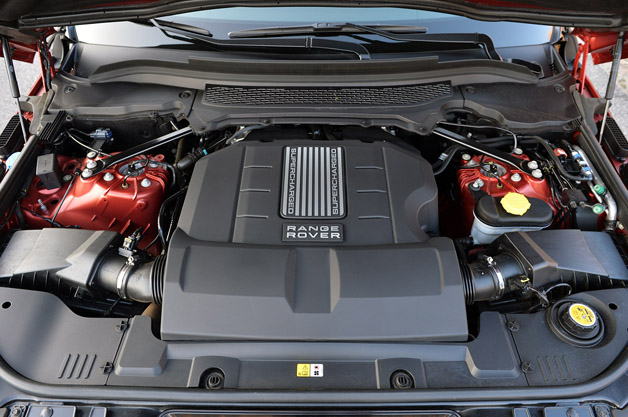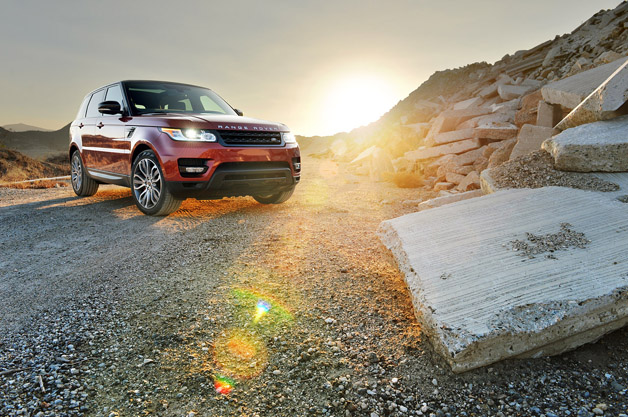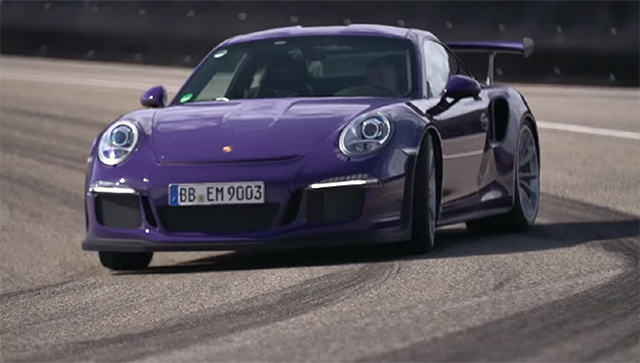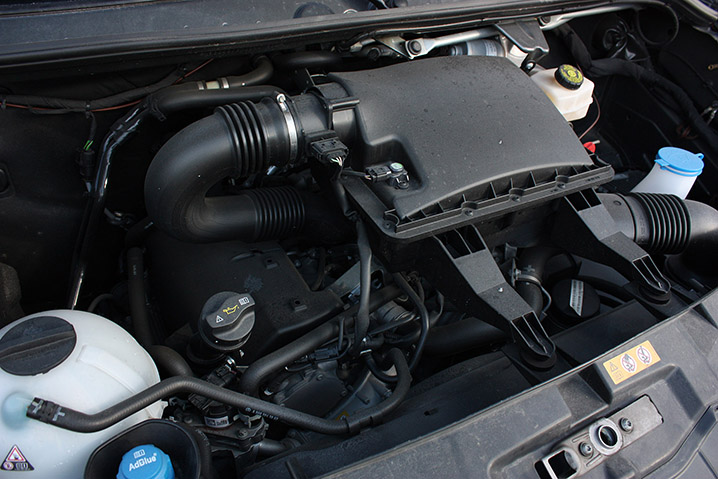
"No
Land
Rover has any business sounding like that!"
My dad's words hung in the air like the few stray puffs of exhaust trailing in
my wake as I motored away from him following a nice dinner. His parting
statement to me really summed up the experience of driving this Chile Red
Range Rover Sport.
This is a vehicle unlike anything else
Land Rover has ever built –
and it needs to be. The Sport has been the British marque's
best-selling vehicle since
it went on sale in 2005 – even in its predecessor's final full year of sales,
2012, it still netted a four-percent bump. That kind of staying power needs to
be preserved.
Doing that would be difficult, though, as Land Rover launched a pair of
particularly notable products before it was time to redesign the Sport. The
Range Rover
Evoque has set the design benchmark for the Land Rover brand, while
the all-new, fourth-generation
Range Rover was
the best
sport utility vehicle Land
Rover has ever built, and arguably one of the very best on the road, full stop.
The task seemed clear, then: build a worthy successor to an SUV that customers
have been clamoring to buy for the better part of decade, while also adding the
design chutzpah of the Evoque and living up to the class-leading standards set
by its big brother.

By now, you have a fair idea of how Land Rover has done.
Senior Editor Steven Ewing's initial foray with
a
right-hand-drive Sport in Wales was overwhelmingly positive in both on
and off-road testing. But I believe in double-checking, and as our only review
involved driving on the wrong side of the road in a UK-spec vehicle, it seemed
like a good idea to secure a Sport for a tough-sledding Michigan winter (yes,
that's why the photos for this story were taken in southern California) and see
what's what.
Land Rover continues to offer its phenomenal 5.0-liter,
supercharged V8 in the 2014
Range Rover Sport.
Like the previous model, Land Rover continues to offer its
phenomenal 5.0-liter, supercharged V8 in the 2014 Range Rover Sport. A
completely unnecessary but wholly gratifying 510 horsepower can be called up,
along with 461 pound-feet of torque. Unlike the old Sport, whose engine was
mated to a six-speed automatic, ZF's stellar eight-speed automatic distributes
power. This paddle-shifted automatic doles out the grunt to all four wheels via
a permanent four-wheel-drive system, which in my tester benefits from both an
electronically locking center and rear differential.
The two diffs can be locked and unlocked automagically, in turn, by Land
Rover's second-generation
Terrain Response
system. This latter serves as the nerve center of the Rover's off-roading
systems, and offers drivers seven preset modes in my Supercharged model: Auto,
General, Grass/Gravel/Snow, Mud/Ruts, Sand, Rock Crawl and Dynamic (the latter
setting isn't available on V6 models). The default setting, Auto, is an
overarching mode that completely removes the guesswork from managing the other
settings. A week with the vehicle would prove that I don't much care for it,
but I'm a control freak.

I've always liked the look of the first-gen Sport, but
there's little denying that there was far more
LR3/
LR4 design DNA in that
vehicle than the
Range
Rover it purported to be. This
new vehicle is clearly
inspired by its Evoque kid brother, rather than the full-sized Range Rover, and
there's none of the old LR3/LR4 left in either its appearance or beneath the
skin. This is no bad thing.
There's none of the old LR3/LR4 left in either its
appearance or beneath the skin. This is no bad thing.
As you can see, the Chile Red and black exterior theme on
this tester has been thoroughly carried out. Not only is it equipped with a
Santorini Black roof, but thanks to its optional Dynamic Package, the mirrors,
grille and "Range Rover" badging are blacked out as well. Subtle it
isn't.
That's kind of the idea, though, and the narrow, wraparound headlights and
their LED accents help out. The profile is accented by a sleeker version of
Land Rover's typically upright greenhouse, thanks to the more aggressively
raked windshield, along with the dramatic belt- and rooflines of the new Sport.
A small side grille and a strongly styled side sill are the other main
attractions of the Range Rover Sport's profile. In back, squarish, wraparound
taillights look like they've been plucked and plumped from the Evoque.

One of my primary criticisms of the old Sport was its cabin
– a point of view not helped after sitting inside the spectacular new Range
Rover. This new model, fortunately, is considerably better than the vehicle it
replaces. Material quality is greatly improved, with a dash that's covered
almost exclusively in leather, save for a strip of mesh that runs level with
the instrument cluster and houses the push-button start, central air vents and
glovebox release.
The cabin overall is quite well laid out, with everything in
easy reach.
The center console, home to the shifter, climate control and
Terrain Response system controls, is rendered in high-quality textured aluminum
on my tester, though other finishes are available. Weirdly, the knobs in the
cabin have a real sense of solidity and quality to them, while the buttons –
particularly those below the infotainment screen – feel comparatively cheap,
both in terms of appearance and in action.
The cabin is quite well laid out overall, with everything in easy reach. The
steering wheel is finished in high-quality leather, and like the Evoque and
fullsize model, it wears a "Range Rover" badge in the center. I
wouldn't have minded a slightly smaller-diameter wheel, however, as it would
have lent a bit of credence to the Sport's mission as a more driver-focused
offering.

Being a Range Rover, the Sport offers up quite a high
seating position, which is a great aid to visibility all around. Those seats,
meanwhile, are heated, cooled and offer 14-way adjustability, while being
extremely supportive in nearly any situation. Ingress and egress are hampered
only by the vehicle's high ride height, a factor that can be mitigated by
lowering the air suspension.
Even with incremental improvements, the infotainment still
feels like a last-generation product.
Indeed, the biggest issue I had with the interior was with
its navigation screen. Land Rover claims it's an eight-inch display, but it
almost feels like they're talking about the total enclosure and not the screen
itself. The undersized screen is made worse by the optional 12.3-inch TFT
display used as the main instrument cluster – the latter is a delight to use,
but kind of shows up the center stack screen. More annoying than any size issue
is Land Rover (and
Jaguar's)
infotainment and navigation software, a touchscreen system that has been
confounding users for years now. Even with incremental improvements, it still
feels like a last-generation product – the touchscreen is unresponsive, the
graphics are unattractive and its options limited.
Now, you can get a Range Rover Sport with a supercharged V6. You should not do
this. Yes, you'll save quite a lot on gas. Yes, the overall cost of your
vehicle will be lower. And yes, I suppose there's an argument for environmental
responsibility to be made, but you'll be missing out on so much more.

The availability of 510 hp and 461 lb-ft leads to a raucous
SUV driving experience that may only be matched by the pricier turbocharged
Porsche Cayenne models.
The Sport goes from docile to savage with little effort, although it takes some
practice to distribute all that fury smoothly. Throttle tip-in is a bit
sluggish and weirdly, it almost feels like a turbocharged mill when trying to
aggressively get off the line. The pedal needs to be fed in gradually, rather
than just deploying a full boot from a standstill. At speed, though, the
throttle feels decidedly sharper and the power is just as abundant.
The availability of 510 hp and 461 lb-ft leads to a raucous
SUV driving experience.
Of course, acceleration is helped by the transmission. I'm
sure you're sick of all the talk about ZF's excellent gearbox, but it bears
repeating how good this particular calibration is, with snappier, well-timed
downshifts and right-now upshifts. There's not much hunting between gears,
either, which is part of what contributes to the Sport's potency when
accelerating at speed. While manual mode is quite good – the immediacy of its
shifts is complemented by the snappy action of the wheel-mounted paddles – I
was totally content leaving the gearbox alone to make its own decisions.
Despite all the good things I have to say about this engine's actual
performance, there's another reason you should buy it over the V6: it sounds
brutal. Remember what my dad said above? Hell, it's probably everyone's
reaction the first time they hear the Sport at flank speed. This large,
off-road-read SUV, which can ford 33 inches of water, sounds like a
Jaguar XKR. It's intoxicating.

That said, the Sport is not a
sports car, and therefore, it
should be rather quiet when just cruising along. It is, kind of. My tester's
21-inch wheels weren't the greatest when it came to road noise, so if it's a
major concern, I'd suggest downsizing to the Supercharged model's standard
20-inch hoops, if only to curb the occasional impact harshness brought on by
their thinner sidewalls.
There is some squatting and diving under hard acceleration
and braking, but at this point, it seems to be an almost intentional and
intrinsic Land Rover quality.
To be fair, the affect those 21-inchers have on the Sport's
ride comfort aren't massive. This is quite a smooth rider thanks to its
standard air suspension, adaptive dampers and active roll control. There is
some squatting and diving under hard acceleration and braking, but at this
point, it seems to be an almost intentional and intrinsic Land Rover quality, a
designed-in character-preserving foible. Considering the Sport is designed to
plow through trails and forests that make even the roughest Detroit roads look
freshly laid paths of asphalt, the potholes and imperfections provided by Old
Man Winter were hardly a challenge for my big, red Rover. Nearly every impact
is nicely smothered, barely registering in the cabin beyond a dull thunk.
Where the Sport really impresses, though, is how it feels in the bends. For a
5,100-pound SUV, its handling is both sharp and neutral. Throw the Range Rover
Sport into a bend, and it takes a set and claws through the turn. Switch to
Dynamic mode, and the suspension hunkers down and the torque vectoring kicks
in, switching up the 50/50 split and allowing even more power to be put down
upon corner exit. What's surprising is that even the feedback remains fairly
impressive. You don't know exactly what the grip levels are like, but you have
a pretty fair idea of how hard you can push before things get expensive.

Normally, at this point, I'd mention the off-road prowess of
the Sport. Unfortunately, being December, I didn't have a chance to go off road
(
Ewing's
review has a great recap of the Sport's off-road chops). I did,
however, test the Sport out in some slick, icy, white stuff and found it more
than up to the task. This was a seriously sure-footed steed on Michigan's icy
roads, whether manually switched to Grass/Gravel/Snow or left in Auto.
The Sport's newfound sense of agility is provided not just by this generation's
aluminum-intensive chassis and body construction, it's also aided by its
steering. The electric power-assisted rack feels rather natural in its weighting,
building progressively from its somewhat light on-center effort and into
something with some degree of heft behind it. You'll still know you're driving
a 5,100-pound vehicle when working the Sport's tiller, but it never feels like
a real hindrance. While the steering remains light on center, it's not easily
swayed by potholes or imperfections, lending nicely to the chassis' overall
sense of stability. Feedback isn't quite as good as a
Porsche Cayenne, but
there's sufficient chatter from the steering to know what the front wheels are
doing – you can tell enough about the road surface to make really informed
steering inputs.
Opt for the Supercharged V8 Sport, and you'll get the most aggressive braking
package on offer – 15-inch front rotors and 14.3-inch rears with red-painted
Brembo calipers. Braking was, not surprisingly, very confident.
As I said above, there are a number of very good arguments
in favor of the six-cylinder. I discovered one of them, the V8's
fuel economy, first hand.
It's possible to return the V8's 14-mile-per-gallon city
EPA estimate, but I'm not
wholly certain how anyone might net the 19-mpg highway figure. My average sat
around 15
mpg, thanks in no
small part to my heavy right foot and the big engine's ear-pleasing racket. I
suspect if driven civilly, 16 or even 17 mpg is possible. At 17 mpg city and 23
highway, the V6 is rated significantly better, but either way, this is a
vehicle for OPEC magnates, not Greenpeace supporters.
Pricing is the other argument against the supercharged V8. The bottom line on
the Supercharged model starts at $79,100. Of course, that figure can climb
rapidly, thanks to options like larger wheels, a healthy array of premium
paints and some optional extras and packages. Extra-cost goodies for my tester
included adaptive cruise control ($1,295), Santorini Black roof ($650), black
headliner ($350), 19-speaker Meridian audio ($1,950), rear-seat entertainment
($2,000) and that gorgeous Chile Red paint ($1,800). Land Rover also was nice
enough to add a pair of packages. The $2,500 Dynamic package (TFT gauge
cluster, 21-inch wheels, red brake calipers, black exterior accents) and $3,545
Luxury Climate Comfort and Visibility Pack (including the aforementioned 16-way
power seats, cooler box, adaptive headlights and heated windshield) led to an
as-tested price of $94,085 including a $925 destination charge. Expensive, to
be sure, but considering that the equivalent
Cayenne Turbo has a
base price of $110,400, the Sport is almost something of a value play.

It's this bizarre bargain that would put me behind the wheel
of one of these Solihull SUVs were I doing the shopping. The Range Rover Sport
offers an incredible amount of versatility in a decidedly handsome wrapper –
it's a
luxury car of
the highest order, yet paradoxically, it's a vehicle fully capable of
delighting your inner driver while also possessing the ability to dispatch any
terrain thrown its way. It may not be cheap, but it's the complete package.
As it turns out, my dad was wrong – this Range Rover Sport has every right to
bellow about how good it is.
http://www.boscheuropean.com














/cdn0.vox-cdn.com/uploads/chorus_asset/file/3680850/W150005_medium.0.jpg)



































































